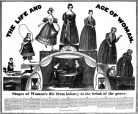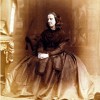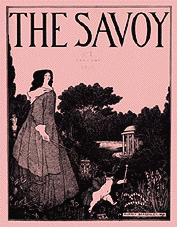The Woman Question
Created by Carrie Sickmann on Thu, 04/18/2024 - 11:03
Part of Group:
Timeline of Events related to Women's Rights
Timeline
Chronological table
| Date | Event | Created by | Associated Places | |
|---|---|---|---|---|
| 1835 |
The Life and Age of WomanIn 1835, The Life and Age of Woman was created and published by A. Alden Barre. The picture depicts the seven phases of a woman’s life during the Victorian era. The caption states: “The virtuous woman is a crown to her husband.” In this image specifically, it shows the life of a woman and what their entire life was supposed to model. From early as age 1, women during the Victorian were made to model the elder women in their lives as well as observe and aspire to be just like them. The little girl is then expected to grow up into a young lady and tend to domestic attributes as well as to serve as a child- bearer and maternal figure. Once the woman reaches age 30, she’s expected to cleanse herself of all sexual and physical pleasures by instead, performing domestic activities such as tending to the house and becoming a great mother. This publication mirrors the life expectancy described in The Tenant of Wildfell Hall, specifically Helen. Helen is trapped within her marriage and can’t leave due to the laws restricting women. She isn’t allowed to run away or perform tasks that she would like to due to all of the legal restrictions. Not only is Helen affected by the social and legal restrictions of women during the Victorian era, but so are all the other female characters.
Brontë, Anne, and Margaret Lane. The Tenant of Wildfell Hall ; Agnes Grey. Dent, 1980. |
Taylon Anderson | ||
| 17 Aug 1839 |
Act on Custody of Infants
Related ArticlesRachel Ablow, “‘One Flesh,’ One Person, and the 1870 Married Women’s Property Act” Kelly Hager, “Chipping Away at Coverture: The Matrimonial Causes Act of 1857″ Jill Rappoport, “Wives and Sons: Coverture, Primogeniture, and Married Women’s Property” |
David Rettenmaier | ||
| 14 Mar 1856 |
Petition for Reform of Married Women’s Property LawOn 14 March 1856, presentation of the Petition for Reform of the Married Women’s Property Law, 1856. The petition began the joint effort by lawmakers and public women to grant married women control of their own wealth. ArticlesJill Rappoport, “Wives and Sons: Coverture, Primogeniture, and Married Women’s Property” Related ArticlesRachel Ablow, “‘One Flesh,’ One Person, and the 1870 Married Women’s Property Act” Anne D. Wallace, “On the Deceased Wife’s Sister Controversy, 1835-1907″ |
David Rettenmaier | ||
| 28 Aug 1857 |
Matrimonial Causes Act of 1857
ArticlesKelly Hager, “Chipping Away at Coverture: The Matrimonial Causes Act of 1857″ Related ArticlesRachel Ablow, “‘One Flesh,’ One Person, and the 1870 Married Women’s Property Act” Jill Rappoport, “Wives and Sons: Coverture, Primogeniture, and Married Women’s Property” |
David Rettenmaier | ||
| 1858 |
English Woman’s Journal first published
Articles |
David Rettenmaier | ||
| 9 Aug 1870 |
1870 Married Women's Property Act
This Act established limited protections for some separate property for married women, including the right to retain up to £200 of any earning or inheritance. Before this all of a woman's property owned before her marriage, as well as all acquired after the marriage, automatically became her husband's alone. Only women whose families negotiated different terms in a marriage contract were able to retain control of some portion of their property. ArticlesRachel Ablow, "On the Married Woman's Property Act, 1870" Related ArticlesKelly Hager, “Chipping Away at Coverture: The Matrimonial Causes Act of 1857″ Jill Rappoport, “Wives and Sons: Coverture, Primogeniture, and Married Women’s Property” Anne Wallace, “On the Deceased Wife’s Sister Controversy, 1835-1907″ |
David Rettenmaier | ||
| 1 Jan 1883 |
1882 Married Women's Property Act
ArticlesJill Rappoport, “Wives and Sons: Coverture, Primogeniture, and Married Women’s Property” Anne Wallace, “On the Deceased Wife’s Sister Controversy, 1835-1907″ Related ArticlesRachel Ablow, “‘One Flesh,’ One Person, and the 1870 Married Women’s Property Act” |
David Rettenmaier | ||
| 14 Aug 1885 |
Criminal Law Amendment Act
Related ArticlesMary Jean Corbett, “On Crawford v. Crawford and Dilke, 1886″ Andrew Elfenbein, “On the Trials of Oscar Wilde: Myths and Realities” |
David Rettenmaier | ||
| Aug 1888 to Sep 1889 |
Jack the Ripper murdersFrom August 1888 to September 1889, the serial killer known as the Whitechapel Murderer or Jack the Ripper stalked women living in the East End of London. Related ArticlesHeidi Kaufman, “1800-1900: Inside and Outside the Nineteenth-Century East End” |
David Rettenmaier | ||
| Jan 1898 to Apr 1898 |
January-April 1896, Aubrey Beardsley Publishes Under the Hill ArticlesSasha Dovzhyk, "The Queer Little Grove: The Adoption of Aubrey Bearsley by Mikhail Kuzmin" |
David Rettenmaier |




